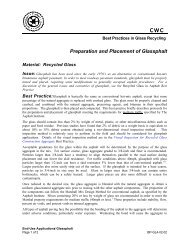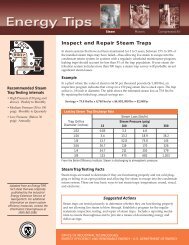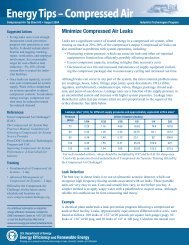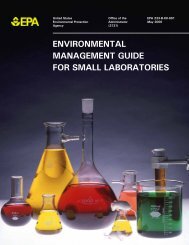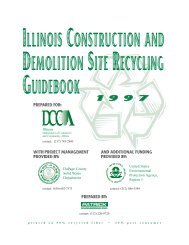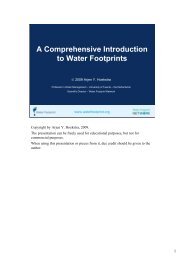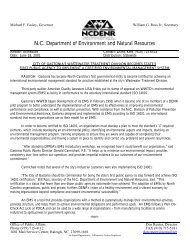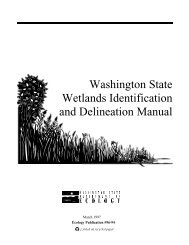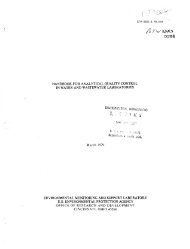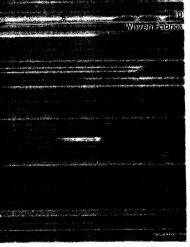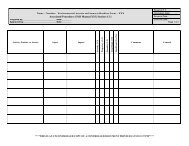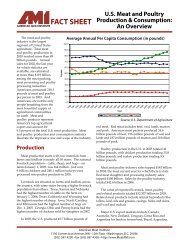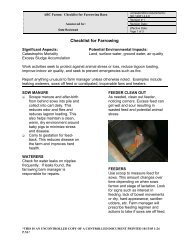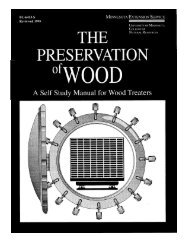Implementing Safer Alternatives to Lithographic Cleanup Solvents to ...
Implementing Safer Alternatives to Lithographic Cleanup Solvents to ...
Implementing Safer Alternatives to Lithographic Cleanup Solvents to ...
Create successful ePaper yourself
Turn your PDF publications into a flip-book with our unique Google optimized e-Paper software.
TABLE III.Hazardous Ingredients in <strong>Lithographic</strong> <strong>Cleanup</strong> Products by Chemical (N=31 chemicals)HazardousIngredientsChemical AbstractNumber (CAS #)Number of Productswith CAS #Concentration% (w/w)Downloaded By: [UOEH - Journal of Occupational and Environmental Hygiene] At: 20:17 10 February 20091 Aromatic hydrocarbons 64742-95-6 10 Not given <strong>to</strong> 502 1,2,4-Trimethyl benzene 95-63-6 7 Not given <strong>to</strong> 293 Aliphatic hydrocarbons 64742-88-7 6 Not given <strong>to</strong>1004 Xylene 1330-20-7 4 Not given <strong>to</strong> 55 2-Bu<strong>to</strong>xyethanol (ethylene glycol 111-76-2 3 1–60monobutyl ether) A6 Diproplyene glycol methyl ether A 34590-94-8 3 1–107 D-Limonene 5989-27-5 3 Not given <strong>to</strong> 108 Mineral spirits 64742-47-8 3 Not given <strong>to</strong> 599 Toluene A 108-88-3 2 5–5410 Solvent naptha, light aliphatic 64742-89-8 2 Not given <strong>to</strong> 10011 Isopropanol 67-63-0 2 < 5–2512 Ace<strong>to</strong>ne 67-64-1 2 Not given <strong>to</strong> 1013 Aliphatic hydrocarbon 8052-41-3 2 Not given <strong>to</strong> 8014 Cumene A 98-82-8 2 Not given <strong>to</strong> 415 n-Hexane and mixed isomers A 110-54-3 1 2116 Diace<strong>to</strong>ne alcohol 123-42-2 1 517 Sorbitan monoleate 1338-43-8 1 1 <strong>to</strong> 1018 2-Propoxy ethanol 2807-30-9 1 Not given19 Propylene glycol t-butyl ether 57018-52-7 1 520 Aliphatic petroleum distillates 64741-41-9 1 4621 Aliphatic hydrocarbon 64741-47-5 1 50–7022 Aliphatic petro distillate (C9–C11) 64742-46-9 1 40–5023 Petroleum naptha 64742-94-5 1 1024 Aliphatic hydrocarbon 6742-89-8 1 > 6025 Aromatic hydrocarbons 70693-06-0 1 5–1026 Dichloromethane (methylene75-09-2 1 45chloride)27 Aliphatic hydrocarbon 8008-20-6 1 30–6028 Petroleum naptha 8032-32-4 1 3529 Ethylphenoxypolyethoxy-ethanol 9036-19-5 1 Not given30 Fatty acid ester TSRN06-0836-331-5005Not clear, numberprovided yielded noresults1 15–3031 1,3,5-Trimethyl benzene 108-67-8 1 Not givenNote: Hazardous ingredients as listed in Section II of product MSDS by name and CAS number. The 20 high-VOC products evaluated contained 31 uniqueCAS numbers and, thus, 31 different chemicals. The duplication and overlap of the names of ingredients listed under the Hazardous Ingredients column, such as“aromatic” and “aliphatic,” reflect the imprecision of how the chemicals were named on the MSDSs.A Skin notation, significant amounts of chemical can be absorbed through the skin and contribute <strong>to</strong> systemic <strong>to</strong>xicity.design of printing presses up <strong>to</strong> the use of cleanup chemicalson the shop floor (Table VI).DISCUSSIONPrinter Exposure <strong>to</strong> <strong>Cleanup</strong> ProductsPrinters participating in this project were exposed on a dailybasis <strong>to</strong> products containing a high concentration of hazardoussolvents (Table II). (7,14−20) At all shops, hand cleaning thepress placed printers’ breathing zones less than an arm’slength away from solvent-soaked cloths in the absence oflocal exhaust ventilation <strong>to</strong> capture the vapors. All printersalso had the potential for skin exposure <strong>to</strong> <strong>to</strong>xic chemicalswhile cleaning the press. For half of the high-VOC products inuse, this hazard was significantly compounded by the capacityof one or more chemical constituents <strong>to</strong> be absorbed throughthe skin in substantial quantities and contribute <strong>to</strong> systemic<strong>to</strong>xicity. Although nitrile gloves were generally reported and/orobserved <strong>to</strong> be available, cleaning without gloves was said <strong>to</strong>routinely occur at one shop and was observed at another.Journal of Occupational and Environmental Hygiene March 2009 181



